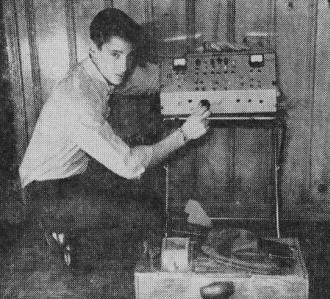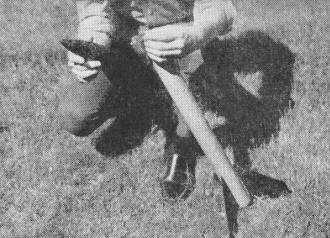|
Lucky thing for budding
amateur rocketeer Allen Wechter that some of the
PETA (formed in 1980) crazies were not around in 1965 when this "World's
First Astrogator" article appeared in Science and Mechanics magazine.
Otherwise, he surely would have been targeted as an animal abuser when he
claimed to be the first person to launch an alligator into [sub]space. The beast
was sent to an altitude of 8,500 feet, whereupon it floated gently down via
parachute. The story mentions that it landed two miles downwind, which in
Flushing, New York, even in 1965, would have been a mighty densely built-up
region of Long Island, near New York City. He's lucky to have retrieved it!
Master Wechter claims the 'gator was "unscratched and in excellent physical
condition," but I'm guessing he was emotionally scarred for life ;-)
World's First Astrogator

Author and rocketeer Allen Wechter poses with electronic monitor
used in the highly automated launching. He's in high school.
By Allen Wechter
Here's how an alligator took a 1000-mph trip in a three-stage model rocket and
was recovered by means of an emergency chute!
Within the last decade, everything from mice to men have been cramped into a
tiny capsule, put aboard a rocket, and fired through the ocean of air surrounding
our planet.
Not long ago in Flushing, N.Y., something new took a journey through that ocean
of air. It wasn't a mouse and it wasn't a man. I put up the first rocket-launched
alligator in the world!
The 'gator was hurtled several miles high - and down-range at about 1000-mph
in a three-foot-high model rocket. The alligator was fastened on a contoured couch
and placed in an oxygen-filled capsule which was the top stage of the rocket.

The baby alligator rocket is loaded just before launching time for rocket.
At T minus 0 seconds, the rocket was fired electronically and lifted off the
launch pad. It soared straight up to an altitude of 3000 ft., when the stages separated
and the second stage fired. The capsule was boosted to a peak altitude of 8500 ft.
At that time, the capsule was ejected away from the second stage. At the moment
the capsule separated, the parachute of the second stage exploded out, while the
capsule itself kept dropping. Then just as I hoped, the electronic brain within
the capsule fired the emergency parachute, as the main chute failed to deploy. For
over 20 minutes the capsule drifted in the air until finally it touched down two
miles away from the launch site. We recovered the capsule and unstrapped the astrogator
to discover that he was unscratched and in excellent physical condition. The flight
was a complete success!
Posted June 15, 2024
|




